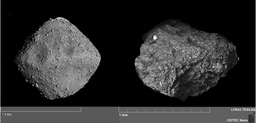The evolution of organic material on Asteroid 162173 Ryugu and its delivery to Earth: Behind the Paper
Published in Earth & Environment

Carbonaceous Asteroid Sample Return
Recent asteroid sample return missions went on among the longest round trips in space exploration, returning to Earth the highest amounts of extraterrestrial material from previously unsampled planetary bodies. The Hayabusa-2 mission was first in carbonaceous asteroid sample return on its ~ 4.5 billion km journey, retrieving ~5 g of sub mm- to cm- sized fragments of Asteroid 162173 Ryugu (Ryugu here on in). Two sites were sampled by touch-and-go (TAG) on the equator of Ryugu, the first from regolith and the second at crater material ejected at lower depths by a ballisticfired by the Hayabusa-2 spacecraft . More recently in September 2023, the OSIRIS REx spacecraft returned samples from Asteroid 101955 Bennu (Bennu here on in). So far, ~130 g of have been curated from the sample return capsule where TAG was performed in a region north of Bennu called ‘Nightingale.’

Earth based laboratories provide the most accurate characterisation of the samples, constraining asteroid classification by remote sensing and linking to Earth’s meteorite, Interplanetary Dust Particle (IDP) and micrometeorite record. Carbonaceous asteroids, the most abundant asteroid type from the Solar System, are particularly unique for their water- and organic-rich content, shedding light on a range of astrophysical and planetary processes: from the evolution of the proto planetary disk; the nature of previously liquid water-rich bodies from the early Solar System such as comets and icy worlds; aqueous and organic physicochemical evolution on those bodies; to their contributions made to early Earth’s water and carbon budget. Remarkably, both Ryugu and Bennu samples are very similar. They are both samples similar to the most water- and organic-rich carbonaceous chondrites in Earth’s meteorite record, CI (Ivuna-type) chondrites, recording the most pervasive degrees of aqueous alteration in extraterrestrial samples.

Grain A0083 (Radegast). (A) Photograph of Hayabusa-2 collection chamber from JAXA. (B) Image of grain A0083 from the JAXA Hayabusa-2 sample database system https://darts.isas.jaxa.jp/curation/hayabusa2/. (C) Higher magnification of A0083. (D) A0083 delivered in Facility-to-Facility Transfer Container (FFTC). (E) Opened FFTC. (F) Inside of the FFTC. The sample was placed on a sapphire dish with a quartz window screwed over the top of it. (Supplementary Figure 4 from the article)
The Analytical Challenge
Mostly being made of loosely bound clay, water derived minerals and organics means that these carbonaceous asteroid samples are the most friable extraterrestrial samples to handle. Our Czech-led Hayabusa-2 consortium was allocated a fresh grain from the 1st TAG site of Ryugu, for the 1st allocation round of samples. The sample was delivered in the facility-to-facility-transfer-container (FFTC) by the Japanese Aeronautic eXploration Agency (JAXA) to our cleanroom at the Heyrovsky Institute of Physical Chemistry, Czech Academy of Sciences. From its raw state, we had to design a method to enable advanced coordinated electron and X-ray microanalysis on the sample, whilst preserving the grain and leaving it intact. This had not been done before. Our method required handling the grain and preparing it to implement focused ion beam- scanning electron microscopy (FIB-SEM) tomography coordinated with more traditional FIB lamella preparation techniques for synchrotron beamtime in a one-chance-scenario.
The Solution
Grain A0083 (Radegast here on in) was prepared at the Central Europen Institute of Technology Nano Brno University of Technology (CEITEC-nano BUT’s) class 100 cleanroom. The grain has to be secured to prevent any microscopic movements up to a Stage tilt ~60o for FIB-SEM. Being an organic-rich, hydrated silicate rock mms in size, charging has to also be avoided for SEM imaging and FIB milling during tomography and ultrathin lamella preparation. A ~ 2 mm diameter divot was made on a clean Au strip mounted on an Al stub with double sided C sticky tape for Radegast to be placed on. The grain was picked up with vacuum tweezers and placed on the Au divot. A ~1.5 mm circular hole in clean Al foil was placed over the top of Radegast and fastened at the edge of the Al stub with the C sticky. The grain protrudes out of the hole and is secured by the tension of the foil around the edge of the grain. Radegast was left uncoated, with charging effects reduced via contact with the foil and Au base. This approach has the advantage that the grain can be turned over by lifting the foil for any future studies whilst leaving it in-tact, without any applied adhesives or coatings.

Preparation of A0083 (Radegast). (A) Schematic of apparatus used for holding the grain as described in the methods section. (B) Image of the grain prior to placing of the Al foil over the top of it. (C) Low kV SE image of the grain after placement of the foil over the top of it. (D) Higher magnification image of the grain protruding from the hole in the foil. (Supplementary Figure 5 from the article)
This simple approach in the sample preparation of Ryugu samples was successful, keeping our sample completely mechanically intact, and prevented any microscopic movements which would have hindered FIB-SEM tomography and lamella preparation for synchrotron beamtime and subsequent transmission electron microscopy. This has additional important implications for future studies of grains from both Ryugu and Bennu, and any delicate small particle analyses.
Follow the Topic
-
Nature Communications

An open access, multidisciplinary journal dedicated to publishing high-quality research in all areas of the biological, health, physical, chemical and Earth sciences.
Related Collections
With Collections, you can get published faster and increase your visibility.
Women's Health
Publishing Model: Hybrid
Deadline: Ongoing
Advances in neurodegenerative diseases
Publishing Model: Hybrid
Deadline: Dec 24, 2025


Please sign in or register for FREE
If you are a registered user on Research Communities by Springer Nature, please sign in